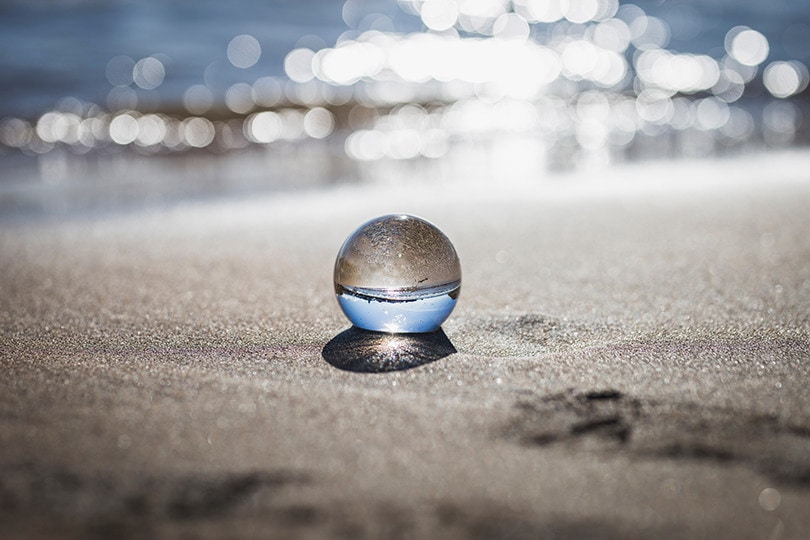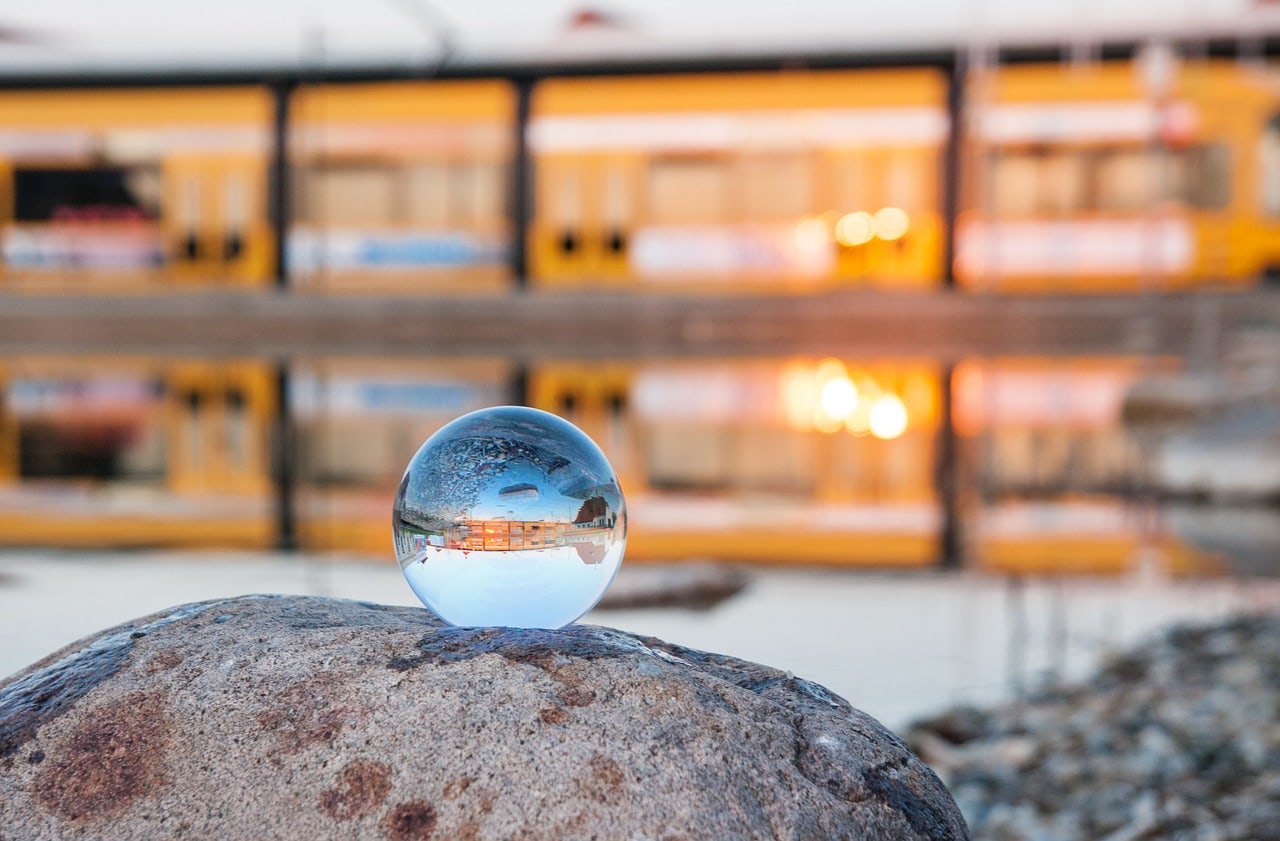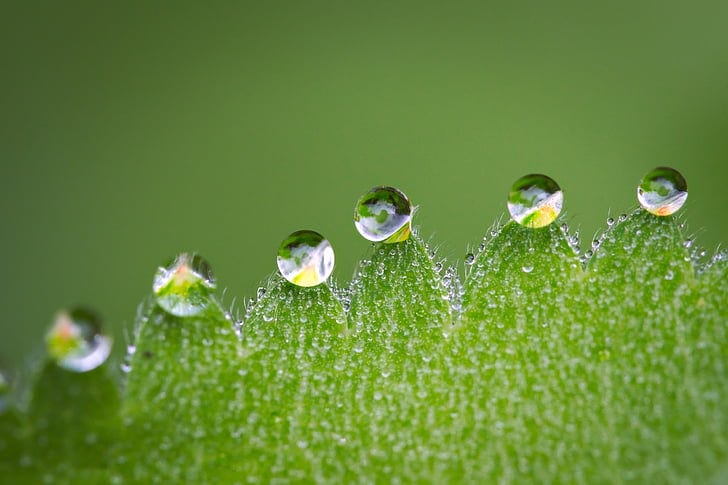10 Lensball Photography Ideas to Get You Inspired
Last Updated on

What some of you might not know is that there is such a thing as “photographer’s block”. We used to think this was something that only affected writers until we experienced it ourselves! The only way to get yourself out of it is to find a way to recharge. You could go for a walk, try a different genre, take a vacation, purchase new gear, or simply be inspired by other people’s work.
Looking at what other people are doing is what often inspires us. And that’s why we decided to create this list. 
The 10 Lensball Photography Ideas to Get You Inspired
1. Nature shots

| Skill level: | Intermediate |
| Lensball size: | 80mm |
Nature photographers are devoted to showing the rest of the world what our planet has to offer, through the eyes of the lens. They’ll capture whatever natural element they find inspiring, including plants, wildlife, different landscapes, human interactions, you name them.
Creating those wild magical moments is no mean feat, but the crystal ball can help you create something unique. You just have to make sure that all your images are close-up shots of the fauna and flora—because that’s what actually constitutes a good nature photograph.
2. Architectural images

| Skill level: | Advanced |
| Lensball size: | 120mm |
Architecture is an art just like any other. That means that whoever decides to employ it, will aim to fulfill both expressive and practical requirements. Needless to say, their ultimate goal will be to satisfy an aesthetic or utilitarian need.
If you’re looking to mimic the work of an inspirational architectural photographer, you should work with a crystal ball. It’s so good at refracting light and making sure all images come out detailed and crisp.
3. Crystal ball portraits

| Skill level: | Intermediate |
| Lensball size: | 100mm |
You know, your portraits don’t have to be bland. A crystal ball can help you spice things up by creating a piece that accentuates the peculiarities of the subject’s appearance.
The post-process is similar to what you’re used to, except this time around, you get to add the effects of the orb.
To eliminate background noise—or achieve a more desirable look—we usually apply a bokeh. And to guarantee the images stand out, we’ll use the orb as the frame.
4. Shooting landscapes

| Skill level: | Intermediate |
| Lensball size: | 120mm |
Taking these types of pictures is not as easy as some landscape photographers make it seem. Just think about it. How many times have you tried to “capture the moment” or a scenic overlook, only to realize your shots are borderline flat and boring? Everything that enthralled you at that particular moment will be in there, but for some reason, that feeling won’t be.
Well, that’s because your eyes are being controlled by the brain to focus on what’s alluring, and ignore the boring stuff. Unfortunately, your lens cannot do that, unless you tell it to. So find a way to stabilize the orb, point the camera’s lens through it, and focus on the compositional elements of the landscape.
5. Macro shots

| Skill level: | Advanced |
| Lensball size: | 80mm |
This subgenre of photography only offers extreme close-up shots. It’s all about showcasing an object larger than it is in real life. For example, taking a 7×7-inch subject shot of an insect that’s not even an inch big.
Macro is certainly a lot more technical and complex in comparison to other types of photography. You have to be great at focusing, redirecting light from the right angles, and merging a wide variety of shots. You’ll also need a special type of lens if you’ll be working with a lensball. One that makes it easier to blur out the background, while focusing on the subject inside your orb.
6. Water reflection

| Skill level: | Beginner |
| Lensball size: | 100mm |
We love working with reflections when creating images because they have a way of completely altering the general aesthetic of the subjects involved. Take water reflections, for example. They’ll transform anything basic into something artistic or abstract.
To pull this off, you’ll have to lay the ball onto something that floats on water. If the item is lighter than the orb, it will sink. It has to be heavier, but not too heavy to sink with extra weight. Also, the water reflection has to be in front of the orb, as it will act as the primary object.
7. Fisheye lens

| Skill level: | Intermediate |
| Lensball size: | 100mm |
They often say what makes someone a good photographer is not his/her experience in the field, but their ability to open their minds to endless possibilities. You just have to be willing to think outside the box, since that’s the only way you’ll start seeing things from a different perspective—like how similar the optics of the fisheye lens is, to that of the lensball.
Novice photographers rarely get the chance to work with fisheye lenses, seeing as most of them don’t come cheap. So they normally resort to crystal orbs, whenever they want to create a sphere-shaped panorama. It’s clunky to some degree, but who cares as long as it produces the same effect.
8. Conceptual photography

| Skill level: | Advanced |
| Lensball size: | 120mm |
Commonly known as abstract photography, conceptual photography is all about producing images that are out of this world. And we mean that in the literal sense. The images have no direct association with our physical world, as they have been manipulated using different applications, materials, and equipment.
One of those materials can be your crystal ball. Of course, the whole shooting process is not going to be easy for an inexperienced eye, but the basics are pretty much the same as those of macro photography. Remember to shoot through the orb, and experiment with different shooting styles.
9. Flipping the horizon

| Skill level: | Beginner |
| Lensball size: | 100mm |
Horizons are important to photographers, especially those who specialize in taking landscape photos. It often helps them create a natural line that anchors and divides the picture at the right point. This concept doesn’t require any skill on your part. Just a little bit of passion and effort.
The first step is to position the orb in a way that makes the land and sky look as though they are flipped upside-down. Stabilize the camera, focus on the essential elements, and take the picture. Once you’re done with the editing work, your shots will look surreal.
10. Sunrise/sunset shoots

| Skill level: | Beginner |
| Lensball size: | 120mm |
The most coveted hour in our profession is the golden hour. Some people like to call it the magic hour since it offers an opportunity to capture breathtaking photos with perfect lighting. In our opinion, it’s the best time to showcase your photography skills using a crystal ball.
The colors surrounding scenes are never distracting to viewers, as they blend seamlessly at every angle. You’ll be working with an atmosphere that looks serene and ensures the audience’s attention doesn’t leave the scene within the ball.
Friendly reminder: don’t forget to flip the image during editing. Otherwise, your sunrise or sunset will appear upside-down.
FAQ
How does lensball photography work?
Have you ever heard of the refractive effect? It’s a phenomenon where light bends or changes direction the minute it hits a transparent or reflective surface. What causes the bending is the difference in mass density between air and the object’s surface. In this case, the lensball.
How do you clean a lensball?
Treat your orb the same way you would a lens. Clean it frequently using pure water, and don’t wipe it off using any piece of cloth that’s not a microfiber cloth. Leaving it out in the sun for a long period of time is also a mistake. Since it works like a magnifying glass, it can burn off your skin! If you’re not ready to use it, leave it in your backpack, or place it in a protective case.

Dan DeAlmeida, Unsplash
How do you use a crystal ball?
The orb often goes in between the lens and the object in focus. So it’s like you’re taking a picture of something, but instead of directly focusing on it, you focus on the image that has been created within the orb. To stabilize the image, you’ll have to place the ball on a tripod, lensball stand, or a solid flat surface.
What’s the standard size of a lensball?
We think an orb with a diameter of 80mm should be the industry standard. Some photographers will obviously hold a different opinion, but you have to think about the weight as well. The larger the orb, the weightier it will be. Even though we do agree with them when they say larger balls usually produce better images in comparison to smaller orbs.
Can you take lensball photos with an iPhone?
This will depend on the model of the phone you’re using. The newer iterations of the iPhone can take great lensball photos since they have specialized camera features that allow them to. But we don’t know about the previous models. You’ll have to give it a try and tell us how it goes.

Final Thoughts
That’s all we had for you today, guys. We hope these ideas will get you inspired and jumpstart your next lensball photography project. Remember, learning is a process. So even if you’re struggling to capture the perfect image now, you’ll get there someday. You just have to practice and keep on practicing.
See also:
- What Is the Best Focal Length for Street Photography?
- 25 Forced Perspective Photography Ideas to Get You Inspired
- 10 Jewelry Photography Ideas to Get You Inspired
Featured Image Credit: Dan DeAlmeida, Unsplash
About the Author Robert Sparks
Robert’s obsession with all things optical started early in life, when his optician father would bring home prototypes for Robert to play with. Nowadays, Robert is dedicated to helping others find the right optics for their needs. His hobbies include astronomy, astrophysics, and model building. Originally from Newark, NJ, he resides in Santa Fe, New Mexico, where the nighttime skies are filled with glittering stars.
Related Articles:
How to Clean a Refractor Telescope: Step-by-Step Guide
How to Clean a Telescope Eyepiece: Step-by-Step Guide
How to Clean a Rifle Scope: 8 Expert Tips
Monocular vs Telescope: Differences Explained (With Pictures)
What Is a Monocular Used For? 8 Common Functions
How to Clean a Telescope Mirror: 8 Expert Tips
Brightfield vs Phase Contrast Microscopy: The Differences Explained
SkyCamHD Drone Review: Pros, Cons, FAQ, & Verdict
